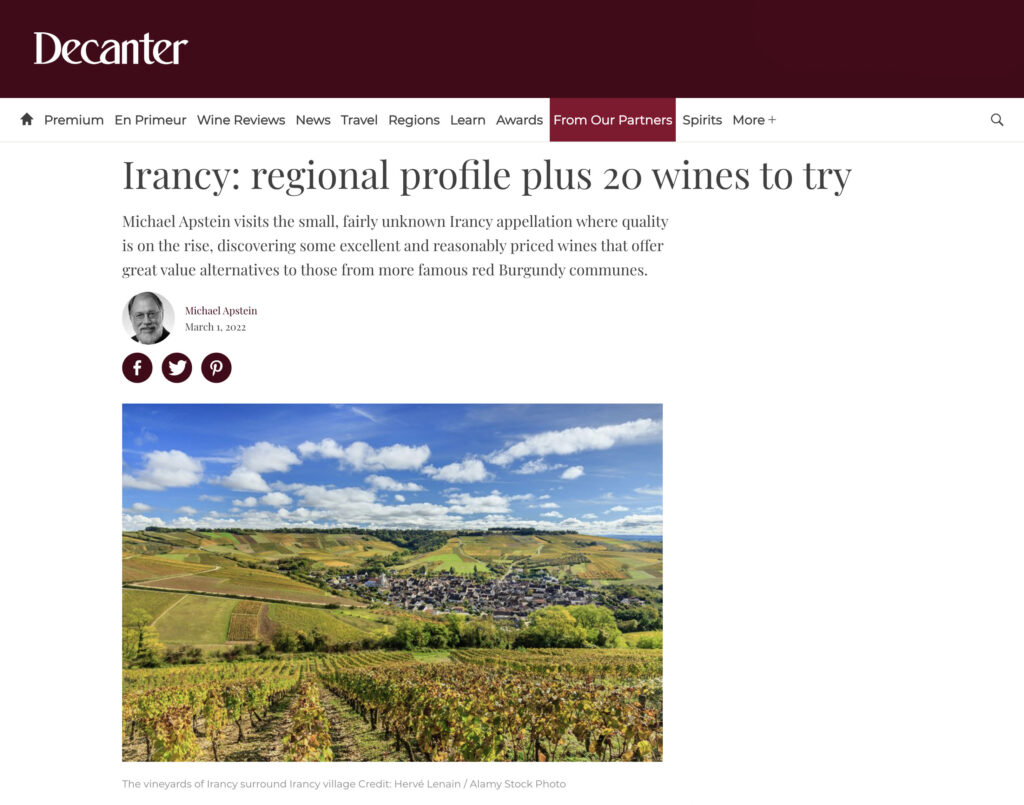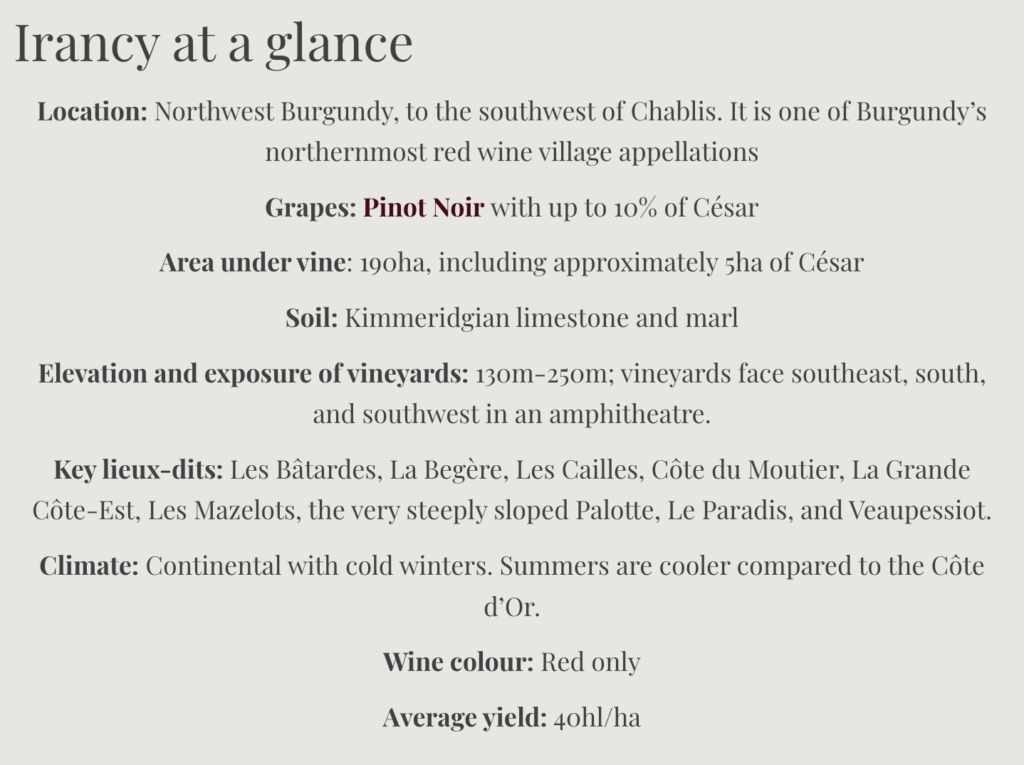
Not familiar with Irancy? Well, you’re not alone. Even though it carries a Burgundy village appellation—high praise, since less than half of Burgundy wines do—more than a few residents of Beaune, to whom I spoke last autumn, could not identify it.
In addition to its off-the-beaten track location near Chablis, regulations allow growers to include up to 10% of César, a near-forgotten red grape, in the blend.
Local lore has it that the Roman legions of Julius Caesar planted César millennia ago. Though DNA analysis of the grape has disproved that myth, the name remains.

Hotter climes beneficial for Irancy wines
Thanks to climate change, the wines of Irancy are now getting their day in the sun – literally and figuratively. Irancy is clearly a hot area (no pun intended). Even though it has no premier cru vineyards (yet), growers are more frequently bottling wines using the names of specific lieux-dits.
Paul Espitalié, director of Chablis-based Simonnet-Febvre, explains that years ago it was difficult for grapes to attain adequate ripeness, and thus their subtle terroir expression was lost.
Nowadays, however, riper grapes allow for better extraction and body, which enables an expression of what are clearly different terroirs.
Awareness of Irancy wines on the up
Négociants have taken advantage of the excellent quality-to-price ratio and have started increasing the visibility of these wines. It won’t be long, therefore, before consumers are able to enjoy more of these great value wines.
Just as well-priced, high quality wines attract consumers, so well-priced land attracts growers.
Espitalié explains that, as expected, vineyards in neighbouring Chablis are very expensive, and to some extent the winemaking philosophy is weighed down by tradition.
It comes as no surprise, then, that young winemakers are buying vines and experimenting with different vinification and viticulture techniques in the less expensive, less rigid area of Irancy. This also explains why many producers of Irancy wines are based in Chablis.
The history of the Irancy appellation
Irancy takes its name from a tiny eponymous village located in the greater Auxerrois area, on the right bank of the Yonne River, barely a dozen miles from Chablis.
With its narrow streets, charming stone buildings, and imposing Gothic church, the village looks like any other hamlet in Burgundy.
It was the birthplace of Jacques-Germain Soufflot, the architect responsible for the Pantheon in Paris.
1936 Wines from Irancy were first included under the Bourgogne umbrella.
1977 Irancy promoted to the Bourgogne-Irancy regional designation.
1998 Irancy gained village appellation status.
Formerly classified as a regional appellation, Bourgogne-Irancy, the wines were upgraded to village status in 1998 as regulators realised their potential. This put them on the same level, within the Burgundy hierarchy, as Marsannay and other villages of the Côte d’Or.
Irancy is now poised to follow Marsannay’s march from a regional appellation, to a village appellation, to a village appellation with premier cru vineyard designations.
The lay of the land
The roughly 190ha of vineyards lie in a south-facing amphitheatre surrounding the village. The back of the amphitheatre blocks the colder northern winds, and the vineyards themselves lie at around 130m-250m altitude.
The soils, similar to Chablis, are a mixture of Kimmeridgian limestone and marl.
As in nearby St-Bris, Chardonnay does not do well here, despite the similar soils and proximity to Chablis.
César
César is a vigorous grape variety, ripening earlier than Pinot Noir, and is known for its power and tannins.
Traditionally, it has been co-planted and harvested with Pinot Noir in Irancy, making it difficult to determine precisely how much of it might be in the blend.
In the past, when Pinot Noir struggled to ripen in this cold locale, growers liked to use a touch of César in their blends to beef up the wine.
Current opinion regarding César’s usefulness varies. Anita Colinot, of Domaine Colinot, has always included it in many of her wines and presumably will continue to do so, since she opts to replant it when necessary. Though she emphasises they are careful to plant it in south-facing sites where she thinks it does best.
Jean-François Bersan, of the family-run Domaine P-L & J-F Bersan, insists that César is ‘part of our heritage, and well managed it can make a significant contribution to the style of the appellation.’
Guilhem Goisot, of Jean Hugues & Guilhem Goisot, a leading producer based in St-Bris, feels differently. He has four rows of César vines, whose grapes he gives to his grandmother. He prefers to use 100% Pinot Noir for his Irancy wines, even though they have less colour and tannin, because he feels the wines are more refined and delicate.
What do Irancy wines taste like?
Though the wines can show considerable variation depending on the vintage and presence or absence of César, in general Irancy wines are a lighter and firmer version of Pinot Noir – with a Côte Chalonnaise-like stoniness – rather than an opulent one, expressing red fruits and often cherry-like notes.
César can add not only colour and backbone, but also a rustic – sometimes charming, sometimes not – element, especially when young.
It would be a mistake to think that wines from a ‘lesser’ appellation, such as Irancy, or Marsannay for that matter, should only be enjoyed when young, or that they lack the capacity to develop with bottle age.
Indeed, a 2015 Irancy from Chablis-based Vincent Dauvissat, appropriately named Soufflot, tasted in November 2021, while still youthful had started to show the marvellous complexity of bottle age.
And a 2012 Domaine Colinot from the Mazelots lieu-dit was just coming into its own when I tasted it in 2019.
Irancy vintage guide
2015 A fabulous vintage in Irancy, as it was for other reds throughout Burgundy.
2016 A small harvest marred by frost and hail. Similar to the rest of Burgundy, the wines are variable.
2017 Hot, with many wines lovely to drink now.
2018 Hot, showing the most ripeness along with supple tannins.
2019 Energetic wines with a good balance of richness and acidity.
2020 Hot, and although I have not tasted any 202s yet, red Burgundy wines from this vintage show surprisingly good acidity and life considering the early vintage, so I have high hopes for the 2020s from Irancy.
The future of the Irancy appellation
So, where is the appellation headed?
Based on my tastings over the years, it’s clear that Irancy is headed in the right direction as growers continue to refine their wines.
Talk is already underway regarding which lieux-dits might qualify for premier cru status.
Though that designation will likely take another decade, I anticipate that it will occur eventually.
The overall outcome is likely to be similar to what we’ve already seen in Marsannay, another previously overlooked appellation.
As consumers discover the wines of Irancy, demand and prices will surely rise. My advice, explore this appellation and board the train before it leaves the station.
Irancy producers to know:
Domaine P-L & J-F Bersan: Though founded in 1453, this family-run domaine, located in St-Bris, really got its start in 2009 when Jean-François’ son, Pierre-Louis, returned from an internship in New Zealand, thus completing his oenology degree from the school in Beaune. The domaine received the top level of Haute Valeur Environnementale (HVE) certification in 2018 and converted to organic farming in 2020.
Dampt Frères: Founded in the 1980s, this top Chablis-based producer only started planting in Irancy in 2014 and received HVE certification in 2018. It has just over 2ha in Irancy, 97% of which is planted to Pinot Noir and the remainder to César. They harvest by hand, sort the clusters, and age the wine in a combination of oak barrels (two-thirds) and stainless steel tanks for about 16 months.
Maison de la Chapelle: Delphine and Grégory Viennois founded this small domaine in 2014. Currently they produce only about 15,000 bottles of Irancy annually from their 4ha of Pinot Noir. Looking to the future, they have plans to make a cuvée exclusively from César, even though they will not be able to label it as Irancy given the current regulations. Using only wild yeast, alcoholic and malolactic fermentation occurs in one- to five-year-old oak barrels. They bottle all their wines without fining or filtration.
Domaine Colinot: One of the leading traditional domaines of Irancy, Domaine Colinot is run today by Anita and Jean-Pierre Colinot. Their 13ha span the best lieux-dits of the appellation. Except for their bottlings from Les Cailles and Boudardes, their cuvées contain 8-10% of César. Hand harvesting is the rule here followed by destemming and vinification in traditional vats, except for their Cuvée Soufflot, which is vinified in oak barrels.
Clotilde Davenne: Based in Chablis where she founded her domaine in 1989, Clotilde Davenne expanded to Irancy in 2005. She’s a firm believer in César, replanting it to maintain its 10% proportion in her 1.2ha of Irancy vineyards, all of which carry HVE certification. Her winemaking depends on the plot and the year, so there’s no formula. Her keen intuition and talent – for 17 years she was the enologist at Jean-Marc Brocard’s domaine – direct her.
Christophe Ferrari Domaine St Germain: In 2015, Nicolas Ferrari took over from his father, Christophe, who created the domaine in 1987. Though Nicolas maintained many of the traditional techniques his father had adopted, he also embraced more modern ones, including native yeast-fermentation, bottling without fining or filtration, and using non-fermentable yeasts to minimise sulphite use while still maintaining high hygiene standards.
Domaine Verret: Though this domaine traces its history back to 1750, it’s only since 1930 that it has focused exclusively on viticulture. Its 13ha, which are farmed ‘as naturally as possible,’ are spread over the appellation. Damien Verret believes that César holds little interest today, so the vineyards are planted exclusively with Pinot Noir. He keeps yields low, averaging about 38hl/ha, to maintain quality.
Domaine Céline & Frédéric Gueguen: The young Céline and Frédéric both come from Chablis winemaking families. Staying close to home, they established their small domaine in Chablis almost a decade ago, describing themselves as ‘artisan winegrowers.’ They produce a little Irancy from Pinot Noir and have just purchased a plot of César. They will achieve organic certification for their vineyards in 2023. This is a domaine to watch.
